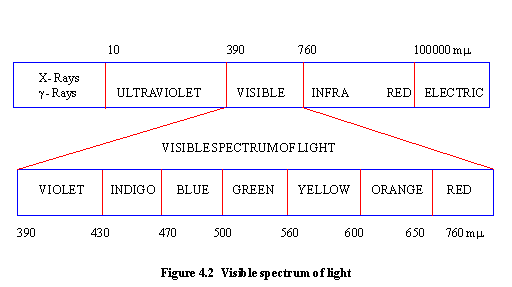|
PinkMonkey Online Study Guide-Biology
4.3 Primary Processes of Photosynthesis
(The photochemical phase, light reaction or Hill reaction)
Nature of light
: As stated earlier, solar radiation is the only natural source
of light for all organisms. Green plants can utilize light belonging to
the visible spectrum only (Figure 4.2) for photosynthesis. This visible
part of the electromagnetic spectrum from the sun is confined between
wavelengths of 390 nm (violet) and 760 nm
(red).
 Click here to enlarge
Click here to enlarge
Light is a form of energy. It appears to travel
as a stream of discrete particles called photons. Each photon contains
one quantum (unit) of light energy. The energy quantity of each
type of light depends on its wavelength. Light with a shorter wavelength
has greater energy; light with a longer wavelength has lesser energy.
Rate of photosynthesis is measured in terms
of the amount of carbon dioxide used (reduced) or oxygen released.
It has been estimated that 8 quanta (photons) of light are required
to reduce each molecule of carbon dioxide (or to release each molecule
of oxygen) during photosynthesis (Emerson and Lewis, 1943). This
is called the quantum requirement in photosynthesis.
Light trapping systems : During the photochemical
phase, light is trapped by the photosynthetic pigments present in
the quantasomes of the grana thylakoids. These pigments are organized
into two pigment systems called pigment system I (PS I) and pigment
system II (PS II).
(I) PS I is composed
of the following pigment molecules:
|
Chl-a 700 (P700) - one molecule
- Reaction center
Chl-a 683 - 200
molecules - Antenna
chlorophyll
Carotenoids - 50
molecules - Accessory
pigments
|
(II) PS II is composed
of the following pigment molecules:
|
Chl- a 680
|
-
|
one molecule
|
-
|
Reaction center
|
|
Chl- a 670
|
-
|
200 molecules
|
-
|
Antenna chlorophyll
|
|
Chl- b
|
-
|
up to 200 molecules
|
}
|
Accessory pigments
|
|
Carotenoids
|
-
|
up to 50 molecules
|
In both the systems, all pigment molecules help in trapping light energy. However, all other molecules transfer their energy to the reaction center to be used for the photochemical reactions in photosynthesis.
|